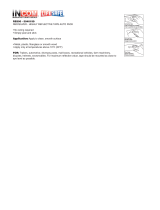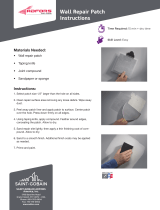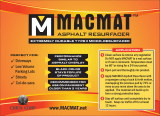Page is loading ...

RestorePro
TM
Concrete Resurfacer
625
• Resurfacewornandspalledconcreteto
providea“newconcrete”nish
• Easytoapply
• Hardensquickly
• Freeze-thawresistant
• Suitableforfootandrubbertiretrafcon
commercialandresidentialapplications
• Useforinteriorandexterioroorsandwalls
The W.W. Henry Company
400 Ardex Park Drive
Aliquippa, PA 15001
(724)203-8000
1-800-232-4832
www.wwhenry.com
The Professional’s Formula For Success
™

RestorePro
TM
Description and Usage
HENRY® 625 is a concrete resurfacing compound modied with high-performance
polymers for exceptional bond strength. Formulated from a blend of Portland cement
and other hydraulic cements, HENRY 625 can be used over the surface of existing
concrete to produce a new wear layer as well as to ll in small surface defects, such as
spalls and gouges. Ideal for sidewalks, patios, plazas, courtyards, walkways, driveways,
parking garages, pool decks and most vertical concrete surfaces. When mixed with
water, the result is a creamy, smooth, slurry consistency that can be applied by trowel,
squeegee or hopper gun. Once applied, HENRY 625 can be broom textured before it
sets for a reduced-slip surface.
Substrate Preparation
All concrete substrates must be structurally sound, solid, thoroughly clean and free of
any form release, sealers or paints, patching compounds, dust, dirt, oils and any other
contaminant that could act as a bond breaker. If necessary, mechanically clean the oor
down to sound, solid concrete by shot blasting, grinding or similar. High-pressure (5000
psi) power washing may also be used to remove dust, dirt and debris, though the concrete
must then be allowed to dry thoroughly before proceeding. Overwatered, frozen or otherwise
weak concrete surfaces must also be cleaned down to sound, solid concrete by mechanical
methods. Acid etching, adhesive removers, solvents and sweeping compounds are not
acceptable means of cleaning the substrate. The use of sanding equipment is not an
effective method to remove curing and sealing compounds. Clean debris out of expansion
joints and tape or mask the joints off to prevent HENRY 625 from lling the joint. Use a lawn
edger to clean around the walk or driveway, as well as around planter boxes and landscaped
areas. Substrates must be dry for a successful installation.
The concrete substrate must be absorbent to receive HENRY 625. Any additional
preparation required to achieve this must likewise be mechanical.
Substrate and ambient temperatures must be a minimum of 50°F (10°C) for the
installation of HENRY products.
Please note that when removing existing ooring, any asbestos-containing materials
should be handled and disposed of in accordance with applicable federal, state and
local regulations.
Recommended Tools
Mixing buckets, margin trowel, steel trowel, ne or medium-bristle nishing
broom, 3” paintbrush (for edging), squeegee, hopper gun (where required),
mechanical mixing paddle and a 1/2” (12 mm) heavy-duty drill (min. 650 rpm).
Joints and Moving Cracks
Under no circumstances should HENRY 625 be installed over any joints or any moving
cracks. All existing expansion joints, isolation joints, construction joints and control joints
(saw-cuts), as well as any moving cracks, must be honored up through the topping by
installing a exible sealing compound specically designed for use in moving joints. Failure
to do so may result in cracking and/or disbonding of the topping. Even the slightest amount
of movement in a control joint will cause the HENRY 625 to show a hairline crack in a
pattern reective of the joint. W.W. HENRY cannot be responsible for problems that arise from
joints, existing cracks or new cracks that may develop after the system has been installed.
Dormant Cracks
Before proceeding with the installation, all dormant cracks must be prelled with a
fully rigid, high-modulus, 100% solids material. Please note that the repair material
must be sand broadcast to refusal while still fresh and allowed to cure fully prior to
removing all excess sand.
The lling of dormant cracks as described above is recommended to help prevent
the cracks from showing through the dressing. However, should movement occur,
cracks will reappear.
625
Priming
No priming is required over standard absorbent concrete. However, to minimize the
potential for pinholes forming in HENRY 625 installed over highly absorbent concrete,
as well as to increase the working time of the HENRY 625, the concrete can rst be
primed with HENRY® 635 SealPro™ High Performance Concrete Sealer diluted 1:1
with water. Allow the primer coat to dry thoroughly (min. 3 hours depending upon
jobsite conditions) and proceed with the installation of HENRY 625 using the normal
installation practices outlined below.
Mixing and Application
For one 40 lb. (18 kg) bag of HENRY 625, use 5 quarts (4.75 liters) of clean water.
Pour the water in the mixing container rst, and then add the HENRY 625. Do not
overwater! For best results, mix with a mechanical mixing paddle and 1/2” (12 mm)
heavy-duty drill (min. 650 rpm). Mix thoroughly to obtain a lump-free consistency.
To mix smaller quantities by hand, use 2.75 parts powder to 1 part of water by
volume. Use a margin trowel and mix vigorously for 2 to 3 minutes.
The pot life of HENRY 625 is approximately 30 minutes at 70°F (21°C). If the product
begins to set in the bucket within this time, remix before using. Do not add more
water! In warm weather, use cold water to extend the working time.
Pour the mix onto an area of concrete and at trowel, squeegee or broom it onto
the surface while applying enough pressure to ensure good dressing-to-concrete
contact. Maintain a “wet edge” during installation to help minimize natural color
variations that can occur between sections. Immediately apply a light broom-nish
to achieve the desired texture, working in areas small enough to permit nishing
without walking on the freshly installed dressing. HENRY 625 has a working time of
approximately 10 to 15 minutes, depending on jobsite conditions.
On vertical surfaces such as walls or stair faces, trowel, brush or spray the dressing
using a hopper gun directly onto the prepared area. Smooth or brush the material to
the desired nish.
For minor patching, lling small holes, gouges or spalls (up to 1” [25 mm] diameter
and 1/2” [12 mm] deep), mix 4 parts powder to 1 part water by volume and apply
to the prepared surface with a at steel trowel or putty knife. Repair areas should
be allowed to set rmly (30 to 45 min. at 70°F/21°C) before applying the nish coat
of the dressing. Cool ambient and surface temperatures will slow setting time. For
larger or deeper repairs, use HENRY® 615 PatchPro™ Exterior Concrete Patch.
Thickness of Application
HENRY 625 is to be installed in as thin a layer as can be placed while getting full
coverage. Typical installation thickness ranges from 1/16” up to 1/8” (1.5 to 3 mm),
and HENRY 625 can be applied at a thickness of up to 1/2” (12 mm) in small, well-
dened areas (see above). Please note that thicker areas will take longer to set than a
dress coat, and will reduce the overall coverage.
Color
HENRY 625 is formulated from Portland cement and other hydraulic cements and is
available in gray. As concrete color and jobsite conditions vary widely, it is not intended
that this will match the color of the concrete being resurfaced or an adjacent concrete pad.
Jobsite conditions such as direct sunlight and wind, as well as the surface of the dressing
being exposed to moisture before it often completely sets, can lead to color variations in
the appearance of the dressing. Should this occur, it often can be corrected completely by
pre-wetting the surface of the discolored dressing and misting it with a vinegar solution
diluted with 3 parts water. Allow the vinegar to stand on the surface for a minimum of
10 minutes without allowing it to dry. Rinse clean and allow to dry thoroughly. Should
the condition persist, a pigmented sealer such as HENRY 635 Gray can be used.
Consult the W.W. HENRY Technical Service Department for additional information.

Curing
Although HENRY 625 requires no special curing procedures, avoid applying this product
if rain is expected within 6 to 8 hours or freezing temperatures could occur within 24
hours of application. As with any cementitious material, these conditions can alter the
appearance and performance of the dressing.
Wear Surfaces
As is the case with all concrete surfaces, HENRY 625 should be sealed with a waterborne,
breathable concrete sealer to prevent dusting and to help resist damage from standing
water, salt and oil, as well as staining and marking. HENRY 625 can be sealed as soon
as the dressing hardens sufciently to work on without damaging the surface. HENRY
recommends the use of HENRY 635.
Reflective Cracking
HENRY 625 is formulated as a highly durable, nonstructural wear surface. As such, it
is important to note that no one can predict with 100% accuracy the appearance of
cracking in a non-structural topping. While there can be several causes for cracking, it
must rst be understood that the installation of thin layers of non-structural toppings are
not capable of restraining movement in the structural slab, which could lead to reective
cracking. Areas most likely to telegraph include those with deection of a concrete slab,
vibration of a concrete slab in metropolitan areas due to truck trafc and subways,
existing cracks in the oor, control joints or saw-cuts, expansion joints and small cracks
off of the corners of metal inserts such as electrical boxes or vents in the oor. We know
of no method to prevent this telegraphing from occurring.
Notes
The pot life of HENRY 625 is approximately 30 minutes at 70°F (21°C), while the working
time is approximately 10 to 15 minutes. Pot life and working time will vary with ambient
temperatures.
Always install an adequate number of properly located test areas, including the sealer and
any desired colorants, to determine the suitability and aesthetic value of the products for
the intended use. As sealers vary, always contact and rely upon the sealer manufacturer for
specic directives regarding intended end use of the product.
HENRY 625 is intended for resurfacing interior and exterior concrete in residential and
commercial applications subject to foot and rubber-wheeled trafc. HENRY 625 is not
intended for industrial uses such as heavy manufacturing or areas with heavy truck trafc.
Do not use in fountains, inside swimming pools or in any areas that will be submerged
permanently.
Do not mix with cement or additives. Observe the basic rules of concrete work. Do not install
below 50°F (10°C) surface and air temperatures. Install quickly if substrate is warm, and
follow warm weather instructions available from the HENRY Technical Service Department.
Precautions
Carefully read and follow all precautions and warnings on the product label. For complete
safety information, please refer to the Material Safety Data Sheet available at
www.wwhenry.com.
Technical Data According To W.W. HENRY
Quality Standards
All data based on a mixing ratio of 2.75 parts powder to 1 part water by volume at
70°F (21°C). Physical properties are typical values and not specications.
MixingRatio: 5 quarts (4.75 L) of water per one 40 lb. (18 kg) bag; for
smaller batches, mix 2.75 parts powder to 1 part water
by volume.
ApproximateCoverage: Up to 120 sq. ft. per bag at 1/16” (11.1 sq. m at 1.6 mm)
Up to 60 sq. ft. per bag at 1/8” (5.5 sq. m at 3.2 mm)
Application methods and the texture of the concrete being
coated will affect these rates.
CompressiveStrength
(ASTMC109/mod–
Aircureonly): 4,000 psi (27.6 N/mm
2
) at 28 days
PotLife: 30 minutes
WorkingTime: Approx. 10-15 minutes
Walkable: Approx. 2 hours
InstallWaterborne
Coating: When hard (approx. 2 hours)
CureTimeto
ReceiveTrafc: Consult sealer manufacturer
Color: Gray
VOC: 0
Packaging: 40 lb./18 kg net weight bag
Storage: Store in a cool, dry area. Do not leave bags exposed to sun
ShelfLife: 1 year, if unopened
Warranty: W.W. HENRY Standard Limited Warranty applies
©2012 W.W. HENRY L.P. All Rights Reserved
/





